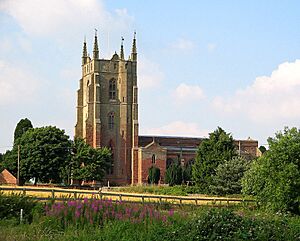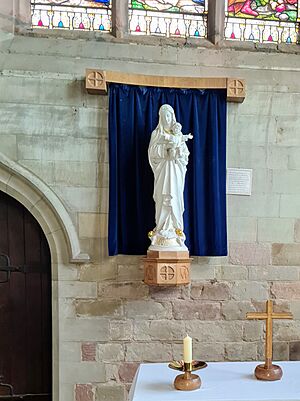Monks Kirby Priory facts for kids
Monks Kirby Priory was a special kind of monastery called a Benedictine priory. It was built way back in 1077 in a village called Monks Kirby, in Warwickshire, England. This priory closed down in 1415. Its lands and money were then given to another monastery, the Carthusian priory of Axholme in Lincolnshire. They kept it until a big change called the Reformation happened much later. Today, parts of the old priory are still part of the village church in Monks Kirby.
Contents
Building the Priory in 1077
The church in Monks Kirby was very old, even before the Normans arrived in England. It was likely a large and important church called a "minster" during the Anglo-Saxon times. After the Norman Conquest, a Breton knight named Geoffrey de la Guerche took over the land around Monks Kirby. He rebuilt the old Anglo-Saxon church, which had been damaged, possibly during fights between the Saxons and Normans.
Geoffrey made the rebuilt church into a priory. This meant it was connected to a larger Benedictine Abbey called St. Nicholas in Angers, France. We still have the original paper that started the priory, dated July 1, 1077. This paper is special because it shows something that often happened after the Norman Conquest: a marriage between a new Norman lord and the daughter of the old Anglo-Saxon lord. Geoffrey married Ælgifu, whose father, Leofwin of Newnham, was related to important Anglo-Saxon figures like Leofric, Earl of Mercia and Lady Godiva.
In the founding paper, Geoffrey gave the church of Kirby and two priests to the new Priory. He also gave some of his local land, like the village of Copston Magna, and rights to other money and goods from his lands across the country. Monks Kirby Priory was named to honor the Virgin Mary and St Denis. The paper also tells us the names of the first monks who came from France: Geoffrey, Ranulf, Stephen, Maurice, Roger, and Herman. The two priests, Frano and Osgot, were probably the priests from the church before the Normans arrived.
The Benedictine Priory's History
A Powerful Priory in the 1100s and 1200s
After Geoffrey died, his lands, including Monks Kirby, went back to the King. The King then gave them to Nigel d'Aubigny. His son, Roger de Mowbray, and his family later became very important nobles.
Throughout the 1100s, the priory became more and more important. The Mowbray family and others gave it new lands and money. The fact that the Plantagenet family, who came from Angers (where the main abbey was), became the Kings of England probably helped Monks Kirby Priory become more well-known. In the 1170s, a monk named Richard of Waterville was sent from Angers to be the Prior (leader) of Monks Kirby. He later became the Prior of Whitby and was important in building that town.
We don't know much about how the monastery was laid out. However, it must have had a library and possibly a Scriptorium, which is a room where monks copied and decorated books. One beautiful book from the priory, made in the late 1100s, still exists today. It is now kept at Balliol College, Oxford. This book tells a story about a statue of the Virgin Mary and child in the Kirby church that stopped two thieves. One of the thieves even changed his ways and visited the priory every year!
Only a small part of the 1100s building has been found. In 1977, during a small dig, a blocked doorway was found along the north wall of the church. It had round columns with zigzag patterns, which were common in late Norman architecture.
The oldest parts of the priory church that we can still see today were built in the 1200s. This shows the priory was still growing in importance. In 1266, King Henry III even allowed the monks to hold a fair at Midsummer and a weekly market in Kirby.
Challenges in the 1300s
The late 1300s saw more rebuilding of the priory church, making it look much like it does today. One of the church's bells, still used now, is from this time.
However, this rebuilding happened after almost a century of big problems. The Hundred Years War with France caused the monastic community to struggle. The Abbot in Angers lost control because the King of England started taking the money from French-controlled priories (called "alien" priories) across the country. Foreign monks were also sent away.
Problems for these French priories began in 1295 when the war with France started. By 1330, there were serious issues at Monks Kirby Priory. The Benedictine monks had to be reminded by the Bishop about basic rules, like not allowing women into the monastery and their duty to help the poor.
In 1360, the monks wrote to the Pope. They said that "Christ had performed many miracles in honor of His Mother in the church of the said priory." But they also said the church was "old and in danger of ruin." The monks wanted to raise money by offering special forgiveness to pilgrims who visited and gave donations to help fix the church.
By 1376, the French priories were under more and more pressure. A French knight fighting for the English, Thierry de Robessart, made a deal with the Abbot of Angers. He leased the Kirby Priory lands for 25 years. English royal records show the King agreed to this lease. They noted that Robsart paid the Abbot "a great price" for the lease and had to pay £40 each year to the King in taxes from the estate. Thierry de Robessart died in 1387. In 1390, the King confirmed that Thierry's son, Jean (or John), could keep the lease for the rest of the 25 years.
The Robsarts only kept two monks at the Priory. The Abbot of Angers, who had not received money from the Priory for a long time, offered to give the land and the Priory to Thomas Mowbray, Earl of Nottingham, for a good price. In 1396, Mowbray accepted the offer. He wrote a letter to the Pope saying that the number of monks at Kirby Priory, which was supposed to have seven, had not been kept up. Only two monks lived there, and the rules were not followed. He also said that the money was not being used for good purposes, and the buildings were falling apart because of the monks' behavior and the wars between England and France. Mowbray wanted the priory and its money to be given to the Carthusian Abbey he was starting on the Isle of Axholme in Lincolnshire.
It took another 20 years for Mowbray's wish to be granted. In 1399, relations between England and France got better, and the Abbey at Angers got back its rights to its houses in England, including Monks Kirby. But the good relations didn't last. In 1415, the Axholme Carthusians finally took over Monks Kirby priory and its money. After 338 years, the Benedictine monks left Monks Kirby.
Transfer to the Carthusians
In 1415, King Henry V agreed that the Duke of Norfolk could transfer the priory and its lands from French control to become part of the Carthusian Abbey on the Duke's lands in Lincolnshire. By 1415, the connection between Monks Kirby and Axholme was already over 350 years old. Both places had belonged to the Anglo-Saxon Leofwin, then to Geoffrey de la Guerche after the Conquest, and later to the Mowbray family. This transfer was a reversal: since 1077, money from Axholme had gone to Monks Kirby priory, but now Monks Kirby's money would support the new Axholme Abbey.
The church was changed again in the late 1400s. An eight-sided spire was added, which must have been a very noticeable landmark in the area.
The Carthusians in Axholme lived a very strict monastic life. The money from Monks Kirby priory provided most of their income. There were no monks living at Monks Kirby anymore. In 1535, Axholme paid for a vicar (a local priest) at Monks Kirby and for a chantry priest. We don't know who the chantry priest prayed for.
The Newnham Paddox Estate, next to Monks Kirby, was owned by the Newnham family under the Mowbrays from the 1100s. Different families owned the estate in the 1300s and early 1400s. Then, on November 11, 1433, John Fildyng (or Feilding) bought it. Fildyng was a descendant of the earlier Newnham family. The Feildings made their estate bigger by buying part of the Monks Kirby manor (the lands that belonged to Monks Kirby priory) from the monks at Axholme in 1515.
The Reformation Period
During the Reformation, King Henry VIII took control of the Axholme priory's assets. The King gave the remaining lands of the Monks Kirby Manor to Thomas Manning, who was the Bishop of Ipswich. At the same time, the King gave the church's main income and the right to choose the vicar to his new college, Trinity College, Cambridge.
After the Reformation
The priory church became the main church for the village of Monks Kirby. You can still see clear parts of the old priory built into the north wall of the church and one of its two side chapels.
The manor of Monks Kirby didn't stay with the Bishop of Ipswich for long. Several different owners had it over the next 80 years. This included the family of Lady Jane Grey. Her father, Henry, the first Duke of Suffolk, probably paid for the impressive wooden ceiling that is still in the Church today. In the 1600s, a powerful woman called the Countess of Buckingham bought the Manor. She then passed it to her grandson, Basil Feilding, 2nd Earl of Denbigh. This meant the Feilding family came to own both the historic Newnham Paddox estate and the lands that had belonged to the Priory Church of Monks Kirby in medieval times. The Earl of Denbigh owned most of the village and the land around it until the mid-1900s.
The church spire blew down in 1701. The unique decorative walls at the top of the church were added in the late 1700s. The church looks much like it does now because of its last major restoration, which happened in 1869. The church's dedication to Saint Edith of Polesworth was likely brought back in the 1700s. While it's generally believed that the church was dedicated to St Edith in medieval or Anglo-Saxon times, it's not completely clear.
Trinity College sold off a lot of its land around Monks Kirby after the Second World War. However, it still has a connection to the church and is involved in its affairs.
Lasting Impact
In 1977, Monks Kirby celebrated the 900th anniversary of the Priory's founding. The celebrations included a special service at the church with Benedictine monks. On July 1, 1977, 25 monks and 3 abbots from four English Benedictine abbeys performed a special evening prayer, "just as the first seven monks and their prior would have done when the church was dedicated on 1 July 1077." In the 1800s, a Roman Catholic religious community had been re-established in Monks Kirby. The celebrations involved both the Catholic and Anglican communities.
As part of the 900-year celebrations, a small archaeological dig was carried out. This dig found evidence of the church from the 1100s.



